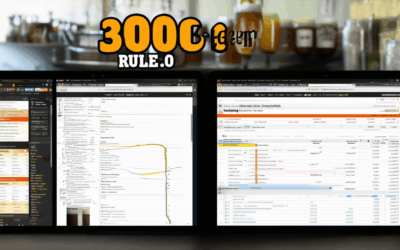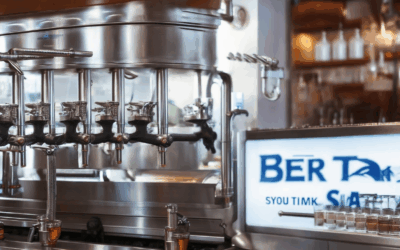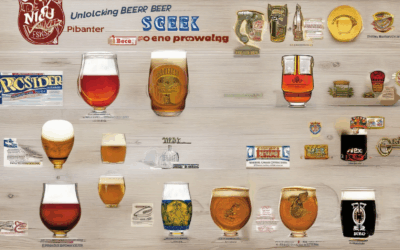In today’s competitive craft beer market, understanding the science behind brewing is crucial for success. While many brewers focus on the artistry of crafting unique flavors, the power of beer analytics often goes unnoticed. By leveraging data and advanced tools, brewers can unlock valuable insights that drive innovation and efficiency. This article dives into the essential tools and strategies that put beer analytics at the heart of your brewing process, helping you make informed decisions that enhance both quality and profitability.

Tools for Analyzing Beer Data
When it comes to analyzing beer data, there are several tools and software solutions tailored for breweries and craft beer enthusiasts. Here’s a breakdown of some of the most effective tools available:
- Excel and Google Sheets : These are excellent for breweries looking to track basic data such as ingredient costs, production logs, and inventory levels. They are user-friendly and suitable for smaller operations.
- BeerDroid : A popular tool for supply chain and production optimization. It helps breweries manage ingredients, track supplier performance, and plan production schedules efficiently.
- Taps : A comprehensive supply chain management solution designed specifically for the beverage industry. It streamlines operations from raw material procurement to distribution, offering real-time insights and analytics.
- BrewersEdge : Known for its detailed production tracking capabilities, BrewersEdge allows breweries to monitor fermentation, boiling, and other critical processes in real-time.
- Tableau : A powerful data visualization tool that breweries can use to create dashboards and reports. It’s ideal for analyzing production data, cost analysis, and market trends.
- Power BI : Similar to Tableau, Power BI offers robust analytics and visualization features. It’s often used by larger breweries to handle complex datasets and provide actionable insights.
- Hopworks : A specialized tool for hop management, helping breweries track hop usage, costs, and availability. It integrates with other systems to ensure seamless workflow.
- Cloud-Based Solutions : Many modern tools now offer cloud-based platforms, allowing breweries to access data remotely. These solutions often include mobile apps, making it easier to monitor operations on the go.
These tools cater to different aspects of beer production and analysis, from basic tracking to advanced insights. Choose the one that best fits your brewery’s needs to optimize efficiency and decision-making.
How Can Beer Analytics Help You Understand Beer Better?
Beer analytics is a powerful tool that allows brewers, enthusiasts, and industry professionals to gain deeper insights into the production, quality, and consumer preferences of beer. By leveraging data-driven methods, breweries can optimize operations, enhance product quality, and stay ahead of market trends.
1. Enhancing Beer Quality Through Data Analysis
- Flavor Profiling: Advanced sensors and lab equipment analyze key components like hops, malt, and yeast to identify subtle differences in flavor and aroma. This ensures consistent quality and helps in creating unique brews.
- Defect Detection: Analytics tools can detect issues like off-flavors or contamination early, minimizing waste and improving product consistency.
- Process Optimization: By tracking variables like temperature, pH levels, and fermentation times, breweries can fine-tune their recipes and production processes for better yield and quality.
2. Streamlining Brewery Operations
- Predictive Maintenance: Analytics predict equipment failures, allowing breweries to schedule repairs and reduce downtime, thus improving overall efficiency.
- Supply Chain Management: Insights into raw material costs and availability enable smarter purchasing decisions, helping breweries manage expenses and maintain profitability.
- Energy Usage Analysis: Tracking energy consumption helps breweries identify areas for improvement, contributing to cost savings and environmental sustainability efforts.
3. Understanding Market Trends
- Consumer Preferences: Analyzing sales data and feedback provides valuable insights into what consumers prefer, enabling breweries to tailor their offerings to meet demand.
- Competitive Analysis: By monitoring competitors’ products and pricing, breweries can position themselves effectively in the market and respond to industry changes.
- Trend Identification: Analytics reveal emerging beer styles and consumer preferences, helping breweries innovate and stay relevant in a competitive landscape.
4. Promoting Sustainability
- Waste Reduction: Analytics track water, energy, and ingredient usage, helping breweries minimize resource consumption and reduce waste.
- Carbon Footprint Analysis: By measuring the carbon footprint of their operations, breweries can identify areas for improvement and adopt more eco-friendly practices.
- Sustainable Practices: Insights from analytics encourage breweries to adopt sustainable packaging options and reduce their environmental impact.
By utilizing beer analytics, breweries can unlock valuable insights that drive innovation, efficiency, and customer satisfaction. Whether focusing on quality, operations, or sustainability, the data provides a roadmap for success in the dynamic craft beer industry.

Best Tools for Analyzing Beer Data
Data analysis is crucial for brewers looking to optimize production, track quality, and stay ahead of market trends. Here are some top tools tailored for beer enthusiasts and professionals:
- The Goods On Tap
- Brewmaster
- Tapsy
- Hop Culture
- CraftBeer.com
About The Goods On Tap
The Goods On Tap is a go-to platform for brewers and beer connoisseurs. It offers detailed brewery reviews, trend insights, and comprehensive data analysis tools to enhance your brewing process.
Brewmaster
Brewmaster excels in data collection and analysis, helping brewers monitor production metrics, track ingredient usage, and identify inefficiencies. Its user-friendly interface makes it ideal for both small and large-scale operations.
Tapsy
Tapsy is known for its advanced analytics, enabling brewers to track real-time data, analyze flavor profiles, and predict consumer preferences. It’s a favorite among craft brewers for its accuracy and ease of use.
Hop Culture
Hop Culture focuses on hop utilization and flavor profiling. It’s a valuable tool for brewers looking to optimize bitterness, aroma, and overall flavor in their beers.
CraftBeer.com
CraftBeer.com offers a robust directory of breweries and beer styles, along with market trends and consumer insights. It’s a great resource for understanding regional preferences and competition.
How These Tools Help Brewers
These tools empower brewers with actionable insights, from optimizing recipes to streamlining production. By leveraging data analytics, brewers can reduce waste, improve yield, and deliver higher-quality products to the market.

How Can Beer Analytics Improve Your Brewing Process?
Beer analytics is a powerful tool that can revolutionize your brewing process, helping you produce higher-quality beers more efficiently. By leveraging data-driven insights, brewers can optimize operations, reduce waste, and stay ahead of market trends. Here’s how beer analytics can elevate your brewing process:
-
Enhanced Real-Time Monitoring
Beer analytics allows you to monitor key parameters during the brewing process, such as temperature, pH levels, and yeast activity. This real-time data ensures consistency and helps identify issues early, reducing the risk of batch failures. -
Predictive Modeling for Better Planning
Using historical data and machine learning algorithms, brewers can predict future outcomes, such as fermentation times and yield rates. This enables precise planning, from ingredient ordering to scheduling production runs. -
Quality Control Optimization
Analytics tools can analyze data from every batch to detect inconsistencies or defects. This helps identify problematic ingredients or processes, allowing you to implement corrective actions and improve product quality. -
Cost Reduction Through Efficiency
By optimizing energy usage, minimizing waste, and reducing downtime, beer analytics can lower operational costs. Predictive maintenance alerts ensure machinery operates at peak performance, further boosting efficiency. -
Sustainability Insights
Tracking water and energy consumption helps brewmasters adopt more sustainable practices. Analytics reveal areas for improvement, contributing to environmental responsibility while lowering expenses. -
Innovation and Trend Adaptation
Staying ahead of consumer preferences is crucial in the dynamic craft beer market. Analytics reveal emerging trends, allowing you to adapt recipes and packaging to meet demand.
To further explore these benefits, visit The Goods On Tap for in-depth insights and resources tailored to craft brewers. Our platform offers detailed brewery reviews, industry trends, and practical guides to help you excel in the craft beer scene.
How Can Beer Analytics Improve Your Brewing Process?
Beer analytics is a powerful tool that can revolutionize your brewing process, helping you produce higher-quality beers more efficiently. By leveraging data-driven insights, brewers can optimize operations, reduce waste, and stay ahead of market trends. Here’s how beer analytics can elevate your brewing process:
-
Enhanced Real-Time Monitoring
Beer analytics allows you to monitor key parameters during the brewing process, such as temperature, pH levels, and yeast activity. This real-time data ensures consistency and helps identify issues early, reducing the risk of batch failures. -
Predictive Modeling for Better Planning
Using historical data and machine learning algorithms, brewers can predict future outcomes, such as fermentation times and yield rates. This enables precise planning, from ingredient ordering to scheduling production runs. -
Quality Control Optimization
Analytics tools can analyze data from every batch to detect inconsistencies or defects. This helps identify problematic ingredients or processes, allowing you to implement corrective actions and improve product quality. -
Cost Reduction Through Efficiency
By optimizing energy usage, minimizing waste, and reducing downtime, beer analytics can lower operational costs. Predictive maintenance alerts ensure machinery operates at peak performance, further boosting efficiency. -
Sustainability Insights
Tracking water and energy consumption helps brewmasters adopt more sustainable practices. Analytics reveal areas for improvement, contributing to environmental responsibility while lowering expenses. -
Innovation and Trend Adaptation
Staying ahead of consumer preferences is crucial in the dynamic craft beer market. Analytics reveal emerging trends, allowing you to adapt recipes and packaging to meet demand.
To further explore these benefits, visit The Goods On Tap for in-depth insights and resources tailored to craft brewers. Our platform offers detailed brewery reviews, industry trends, and practical guides to help you excel in the craft beer scene.

How Can Beer Analytics Improve the Quality of Your Brew?
To enhance the quality of your brew, consider leveraging beer analytics—a powerful tool that transforms raw data into actionable insights. By implementing advanced tracking systems, brewers can monitor every aspect of the brewing process, from ingredient selection to fermentation control. Here’s how beer analytics can elevate your brewing game:
1. Streamline Brewing Processes
Beer analytics allows you to optimize your workflow by identifying inefficiencies and bottlenecks. With real-time monitoring, you can track the performance of your equipment, ensuring consistent production and reducing downtime. This leads to better yield and cost savings.
2. Enhance Ingredient Management
Understanding the impact of each ingredient on the final product is crucial. Beer analytics can analyze water profile, malt usage, and yeast performance, helping you fine-tune recipes for optimal flavor and aroma. For instance, adjusting hop levels based on analytics data can lead to a smoother bitterness in your beers.
3. Improve Fermentation Control
Fermentation is the heart of brewing, and precise temperature control is essential for achieving desired flavors. Analytics tools can provide detailed insights into fermentation temperatures, allowing you to adjust conditions for better yeast health and more consistent outcomes. This reduces the risk of off-flavors and ensures a more reliable fermentation process.
4. Monitor Beer Quality Through Sensory Analysis
Advanced sensors and data collection systems enable brewers to gather sensory data, such as foam stability and pH levels, in real-time. This helps in maintaining consistency and improving the overall quality of your beer, ensuring it meets high standards for taste and appearance.
5. Gain Competitive Insights
By analyzing market trends and consumer preferences, beer analytics can guide your decision-making process. Understanding regional preferences or seasonal demand allows you to tailor your offerings, staying ahead of the competition and meeting evolving consumer demands.
6. Optimize Energy Usage
Energy consumption is a significant operational cost. Analytics tools can help identify areas where energy use can be reduced, such as optimizing heating and cooling systems. This not only lowers costs but also contributes to environmental sustainability.
7. Enhance Customer Experience
With access to detailed quality data, you can provide customers with transparency and confidence in your products. Sharing insights about your brewing process and ingredients can build trust and differentiate your brand in a competitive market.
8. Future-Proof Your Brewery
Adopting analytics solutions prepares your brewery for future challenges, including regulatory changes and technological advancements. By staying informed, you can adapt quickly and maintain your position as an industry leader.
Conclusion
Beer analytics is a game-changer for modern brewers. By providing actionable insights, streamlining processes, and enhancing product quality, it empowers you to create consistently exceptional beers. Embrace this transformative tool today and take your brewing skills to the next level.




0 Comments